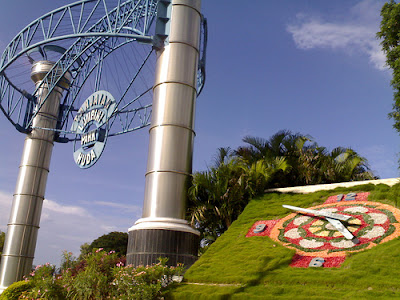Public Domain Photos: Christ the Redeemer (Cristo Redentor), the statue of Jesus Christ in Rio de Janeiro, Brazil - the second largest Art Deco statue in the world and one of the New Seven Wonders of the World. These photos were taken between 2005 and 2009 released as public domain photos by the respective photographers. Click on the photos to view the original sizes/resolution and save to your hard disks for use in your website, blog, etc.
Christ the Redeemer (Cristo Redentor), the statue of Jesus Christ in Rio de Janeiro, Brazil, constructed between 1922 and 1931, is considered the second largest Art Deco statue in the world. Visible from a distance of 20 miles, the statue is 39.6 meters (130 ft) tall and 30 meters (98 ft) wide, weighing 635 tons. It is atop the peak of the 700-metre (2,300 ft) Corcovado Mountain in the Tijuca Forest National Park, overlooking Rio de Janeiro.
Christ the King (Pomnik Chrystusa Króla), the statue of Jesus Christ in Świebodzin, Poland, completed on 6 November 2010 (is 33 meters (108 ft) tall (171 feet/ 52 meters with the mound) weighing 440 tons, is claimed to be the tallest statue of Jesus in the world.
The idea for the statue was first suggested in the mid-1850s, when Catholic priest Pedro Maria Boss requested financing from Princess Isabel to build it, but the idea was dismissed in 1889, when Brazil became an independent republic. The second proposal was made in 1921 by the Catholic Circle of Rio that organized an event called Semana do Monumento to attract donations that came mostly from Brazilian Catholics.
The Brazilian engineer Heitor da Silva Costa designed the statue and it was sculpted by French sculptor Paul-Maximilien Landowski. A group of engineers, architects and technicians who studied Landowski's submissions, decided to construct the statue out of reinforced concrete with the outer layers made of soapstone, designed by Albert Caquot. The Construction took nine years (1922-1931) and cost the equivalent of US$250,000 (approximately US$3.5 million in 2009). The monument was opened to the public on October 12, 1931.
In October 2006, on Christ the Redeemer’s 75th anniversary, Archbishop of Rio Cardinal Eusebio Oscar Scheid consecrated a chapel (under the statue), named after Nossa Senhora Aparecida, the patron saint of Brazil (Our Lady of the Apparition).
Christ the Redeemer was struck by lightning during a violent electrical storm on Sunday, February 10, 2008, causing some damages on the fingers, head and eyebrows, but the damages were repaired by the Rio de Janeiro State Government and the archdiocese.
Christ the Redeemer underwent restoration work in 1980, 1990, 2003 and early 2010. Maintenance work is needed periodically due to the strong winds and heavy rains to which the statue is exposed. In 2003, a set of escalators, walkways and elevators were installed to facilitate access to the platform surrounding the statue.
On 7 July 2007, Christ the Redeemer was named one of the New Seven Wonders of the World in a list compiled by the Swiss-based The New Open World Corporation (second in their list). The other New Seven Wonders of the World are Chichen Itza (#1), a large pre-Columbian archaeological site in Yucatán Peninsula (Mexico), The Colosseum (#3) or the Coliseum, the Flavian Amphitheatre in Rome (Italy), The Great Wall of China (#4) in northern China, consisting of several walls built since the 5th century BC, Machu Picchu or Machu Pikchu (#5), a pre-Columbian 15th-century Inca site, on a mountain ridge above the Urubamba Valley in Peru, Petra (#6), a historical and archaeological city established around the 6th century BC on the slope of Mount Hor (Jordan), and The Taj Mahal (#7), a mausoleum in Agra, India.

















































